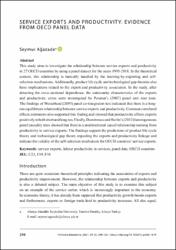Service export and productivity: Evidence from OECD panel data
Özet
This study aims to investigate the relationship between service exports and productivity in 27 OECD countries by using a panel dataset for the years 1995-2018. In the theoretical context, this relationship is basically handled by the learning-by-exporting and self-selection mechanisms. Additionally, product life cycle and technological gap theories also have implications related to the export and productivity association. In the study, after detecting the cross-sectional dependence, the stationarity characteristics of the exports and productivity series were investigated by Pesaran's (2007) panel unit root tests. The findings of Westerlund (2007) panel co-integration test indicated that there is a long-run equilibrium relationship between service exports and productivity. Common correlated effects estimators also supported this finding and showed that productivity affects exports positively in both short and long run. Finally, Dumitrescu and Hurlin's (2012) heterogeneous panel causality tests showed that there is a unidirectional causal relationship running from productivity to service exports. The findings support the predictions of product life cycle theory and technological gap theory regarding the exports and productivity linkage and indicate the validity of the self-selection mechanism for OECD countries' service exports.
Kaynak
Politicka EkonomieCilt
69Sayı
3Bağlantı
https://hdl.handle.net/20.500.12868/1579https://polek.vse.cz/artkey/pol-202103-0002_service-exports-and-productivity-evidence-from-oecd-panel-data.php


















